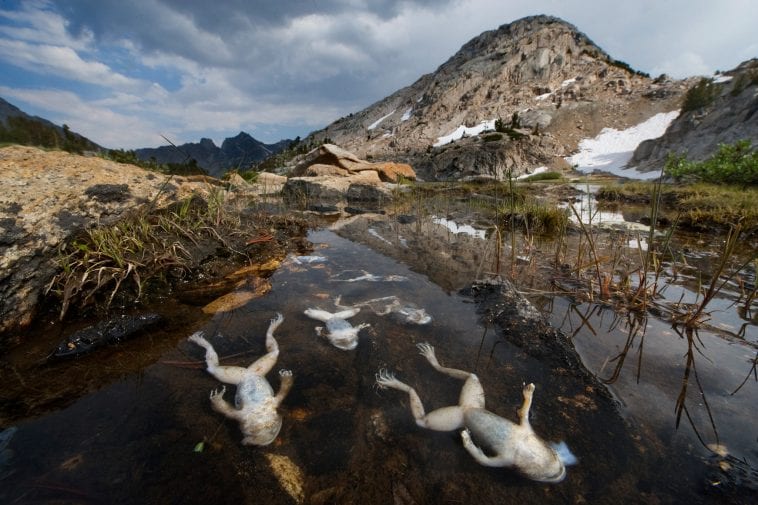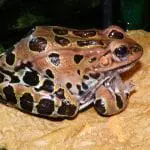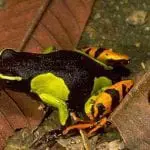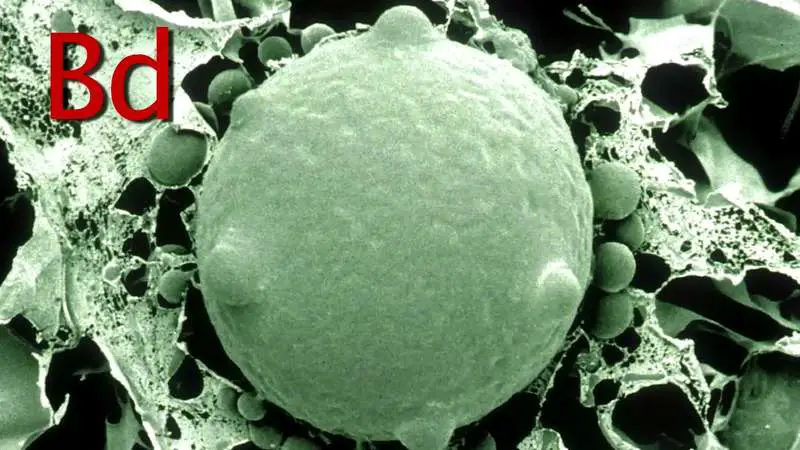
Introduction
What is “chytrid”?
Chytrid is a type of fungus known as the Phylum Chytridiomycota. There are about 1000 different species of this that live in a moist environment. It is one of the oldest types. They are mostly saprobes. That means they eat dead and organic matter that is rotting, while others are parasites living in invertebrate animals. A new species was discovered to infect amphibians’ skin. This was called the Batrachochytrium dendrobatidis or Bd.
For scientists, the name Batrachochytrium is hard to pronounce, but it means “frog chytrid.” Bd is not common since it is the only chytrid, which is a parasite of a vertebrate animal. The amphibians specifically. Bd has not been seen to infect other vertebrates like reptiles, mammals, or birds.

What is Chytridiomycosis?
This infectious disease greatly affects all amphibians worldwide. This is due to Chytrid fungus or the Batrachochytrium dendrobatidis. It is a fungus that is capable of death in some populations of amphibians.
It happens when an amphibian gets a large number of the Bd fungus. The infection happens inside the cell of the skin’s outer layer, which has the keratin. Keratin is responsible for making the outer layer of the skin tough and resistant to any injury. Due to chytridiomycosis, the skin gets so thick. This change is deadly to frogs, especially since they drink and absorb water through their skin and not their mouths. If there is an abnormal level of electrolyte, the heart will stop beating and the animal dies.
In fact, it killed a hundred percent in other amphibians. This is the seen reason for the extinction of some frog species. It was in Queensland when the death of frogs was first discovered. In research, the fungus has been widespread in Australia since the 1970s. It is also present in New Zealand, Asia, Africa, Europe, and Asia. Luckily, some areas are not affected because some amphibian populations were isolated.
Ecology
This fungus lives in the soil or eater, but some are in insects and plants. They asexually reproduce and possess spores that swim in the water. It affects the vertebrae species. Frogs contract this disease as soon as their skin comes in contact with water having spores from the infected ones.
The most affected amphibians are those in permanent waters like the stream, ponds, soaks, or moist bogs. This disease is mitigated strongly by high temperatures. The outbreak happens seasonally. Nonetheless, there are still unknown facts about the fungus, but the interaction between the factors in the environment and the fungus is very important.
Result
Once the fungus invades the frog’s skin, it will cause damage to the outer layer of the keratin. The skin of amphibians is unique. It is physiologically active. It means their skin regulates respiration, electrolytes, and water. Although it isn’t clear yet how the fungus kills, it is thought that the fungus causes disruption to the skin’s normal function, which leads to depletion in the electrolyte and osmotic imbalance.
Some frog populations have died 100% and just some deaths to other species. Others are less susceptible, while some are highly susceptible. Giving antifungal and supportive treatment of adult frogs and tadpoles would help them recover.
Still fortunate, not all amphibians die or get sick with Bd. The African clawed frogs and the American bullfrog have developed their resistance to this disease. However, they are a major concern for they are carriers of BD and can transfer the fungus to new areas and expose other populations to Bd. If researchers find out how some frogs can resist Bd, then there might be methods to control the disease.
Some mechanisms could be the presence of some symbiotic bacteria in the skin that stops the growth of BD. Another is the production from the poison glands termed the antimicrobial peptides, which can prevent the growth of the fungus. Other reasons might be the differences in the environment, including the humidity, temperature, and water flow patterns. High elevations having cool temperatures are optimal for Bd’s growth. Next is the differences in the virulence of strains or types. There is a highly virulent that makes the amphibian sick and the low virulence which causes fewer sick animals.
Although a lot of amphibians died due to Bd, a small number of them have stayed or persisted. Until now, it is not yet known if the persistent ones could recover, reproduce again, or go on extinction. To know if there will be extinction, the level of intensity caused by the infection should be known. The good thing is that the persistent population has less or lower lethal intensity. Understanding these persistent populations could lead to the development of control methods in the wild.
The Spread
This disease is transferred through zoospore. It has a unique appearance having one flagellum that aids the spore in swimming. It needs moisture and cool temperature. It can survive for some months in a moist environment, but cannot tolerate warm of dry temperature. In other words, it is transferred in the water or moist and wet materials or on the infected skin of the amphibian. The most common way is direct contact with the sick one.
In captivity, it is okay that the enclosures are close so long as wet materials and water are not shared between their enclosures. Bd can move also from people’s boots or other equipment. Therefore, biologists must be very cautious in disinfecting their tools and boots.
Symptoms
Sick amphibians can have different symptoms or clinical signs. Tadpoles carry this disease in many cases. Here are some signs to look out for.
- Large numbers of dead froglets or toadlets from May to June or the newtlets from June to September just after the metamorphosis
- Skin flaking
- Lethargy
- Dead amphibians without evident cause of death or signs of disease
- Reddened or otherwise discolored skin
- Excessive shedding of skin
- Abnormal postures
- Seizures
- Unnatural Behaviors
Dead amphibians have a white fungus, or their body is in the pond having skin problems. Many of the signs are non-specific and overlaps with chytridiomycosis. Moreover, some don’t show any signs. They just die. Using the naked eye will be difficult to diagnose if the animal is sick or not.
How to Diagnose
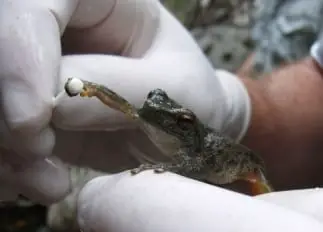
To diagnose, the skin is examined under the microscope and identify the characteristic of BD. It needs the help of an experienced veterinarian or biologists. Swabs on the skin can be gathered and analyzed using the PRC or the polymerase chain reaction. It can detect Bd DNA amounts in samples.
Control
Until now, there are no methods proven in order to control the disease. For the amphibians who are endangered, there are emergency measures needed to increase their population through translocations, reintroductions, and establishing captive disease-free colonies. There should be controlled aims to protect the remaining unaffected areas.
Since strains vary in terms of virulence, it is important to reduce the risk of spread in the infected areas. In addition, there should be a deeper understanding of the impact of this disease in the wild. Surveillances and monitoring are important to detect new outbreaks in the unaffected areas, monitor the effect on the population of frogs, establish control and restricted areas for quarantining and moving restrictions, establish non-infected and infected zones, and monitor the success and progress of any control strategy.
Research
More knowledge is vital for effectively mitigating the results of this disease on the wild amphibians. Therefore, research is still continuing. The priorities of the research are on bio-augmentation, assisted choosing for the innate community, control of the reservoir species, and modification of the habitat.
What Can You Do?
If you find an accidentally relocated amphibian, do not release it in the wild. Give it to a licensed wildlife organization. A displaced frog should be handled using washed single-used vinyl. A plastic bag will be enough too. Then, wash your hands well with disinfectant. To house one temporarily, use containers that are single-use like plastic bags.
It should be disinfected after use. If you find dead frogs in the wild, notify your nearest state environment department. They should be collected using gloves, then diagnosed. To stop the spread, buy amphibians from licensed suppliers only. Don’t release any of your pets. Your tadpoles or frogs must not be moved to avoid the spread of the disease.
Conclusion
Living in the wild is tough for all animals. As they live every day, there are lots of threats. They escape from their predators, but they cannot run away from diseases around them. Every day is a struggle for them. Numerous diseases are waiting to attack them. It is unfortunate that their population goes endangered or could totally disappear. Therefore, as humans, we should do our part by somehow giving them the chance to live in their natural habitat and not take it away from them. That is what we can do for them, at least.

